Tension was palpable in the voices of Mitsubishi Heavy Industries officials in the last few days of March. Despite ongoing talks with potential customers for its proposed Mitsubishi Regional Jet, it was not clear if any would commit before the government's 31 March deadline for the programme's launch.
Ultimately, it went down to the wire. But in typically Japanese style, it proceeded in an orderly manner. All Nippon Airways said on 27 March that it would commit to the MRJ if MHI went ahead, and Mitsubishi's board gave the programme its nod the next day based on the airline's firm order.
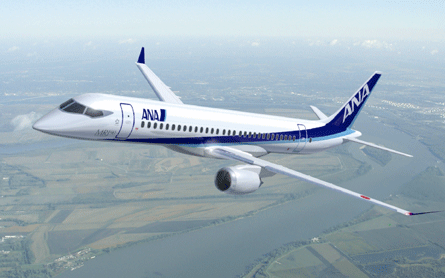 |
|---|
All Nippon Airways' order for the MRJ was the backing Mitsubishi needed to start development |
"We were confident that at least one customer would come on board before the deadline," Nobuo Toda, president of Mitsubishi Aircraft, the MHI subsidiary formed to develop the 70-90-seat aircraft, said in an interview at his office in Nagoya. The relief, though, was evident.
Japan had finally embarked on a plan to transform its aerospace industry into a truly global player with the MRJ as the symbol, and supported by Kawasaki Heavy Industries' indigenous C-X and XP-1 programmes. For many years Japan had been a reliable supplier to airframers like Boeing, Airbus, Bombardier and Embraer. Now it was moving ahead with its own products.
This is a logical progression, say David Pritchard and Alan MacPherson from the University at Buffalo, The State University of New York. "Japan's competitive advantages are strong investments in education and training, endowing Japan with scientific and technical workforces focusing on R&D, along with tapping into global knowledge through direct foreign investment and acquiring leading-edge technologies from Western aerospace suppliers," they point out in a recent paper.
Richard Aboulafia, vice-president for analysis at the Teal Group, adds: "Japan has developed a superb aerospace industrial base and a first-rate status as a major industry partner. Numerous partnerships have allowed Japan to develop myriad skills and to avoid the risks associated with a single aircraft."
FALLING DEFENCE REVENUES
Commercial projects will also help Japanese industry to overcome falling revenues from their military business. "Aside from the C-X and P-X, which appear expensive and problematic, Japanese military aircraft production has almost collapsed. As a consolation for that collapse, Japan's government has decided to fund a Japanese-built regional jet, an idea that has been on the shelf for decades," Aboulafia adds.
Profit levels for commercial aircraft programes rarely exceed 10%, but Pritchard and MacPherson say that the bottom line is not everything: "The primary goal is to position Japan as a legitimate player in a strategically important sector that delivers international prestige to the host, as well as possible technological spillovers to other domestic industries, including the military sector. This might not seem like a wise investment from an economic standpoint, but there is little doubt that Japan is heading down this road with considerable vigour."
Mitsubishi's Toda seems to bear that out, saying: "Aerospace is not just meant to be a growth market for MHI, it is also important for the Japanese economy. This is not just a Mitsubishi programme, it is a Japanese programme."
An overly nationalist impetus does not help a programme, with Japan's NAMC YS-11, a twin-turboprop conceived in the 1960s that was commercially unsuccessful, a case in point. Mitsubishi led that programme and the lessons are clear. "If we have a competitive aircraft that meets the schedule, cost and performance that it promises, we will have a successful programme," says Toda.
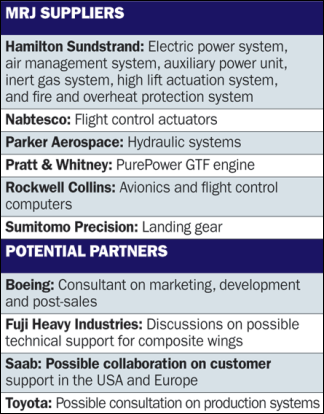
Much of the responsibility lies on the shoulders of Junichi Miyakawa, Mitsubishi Aircraft's executive vice-president for engineering, who is responsible for the design and manufacturing of the MRJ. The aircraft has entered the joint-development phase with the goal of freezing design in autumn 2009, and Mitsubishi is coming to grips with being the lead systems integrator for a change.
"We have not done anything of this scale before, working with many suppliers and pulling all the threads together in a complex programme," says Miyakawa. "Engineers from all of our suppliers are in our offices, and we are constantly discussing the issues related to the aircraft and working together. I like the direction we are heading in."
Composite parts such as the wings will be fabricated at MHI's Oye plant, where the company also produces composite components for the Boeing 787. The suppliers will transport the various parts to MHI's Komaki factory where the final assembly will take place. Ground tests are scheduled to be completed by 2011, with the first flight targeted for late 2011. Certification is likely to take place in 2013, when the aircraft is due to enter into service as well.
The initial production rate will be two aircraft a month, but a maximum number has not been decided. "We will increase the production rate gradually depending on the orders and the delivery schedules," says Miyakawa.
LOW COMPOSITE
Despite expectations that the MRJ will have a significantly carbonfibre component, it will still be a largely metal aircraft. Its structure will be 58% aluminium, 28% carbonfibre, 9% titanium, 4% steel and 1% glassfibre. "Regional jets are operated on high-frequency routes, and that means that the fuselage must be stronger. We did extensive studies and decided that a carbonfibre fuselage is more likely to be damaged by ground vehicles," says Miyakawa.
The industry will closely watch Pratt & Whitney's PurePower geared turbofan engine, which will be launched on the MRJ after beating off competition from an improved General Electric CF34-10 and a variant of Rolls-Royce's RB282. It will be rated at 17,000lb thrust (76kN) on the 86-96-seat MRJ-90, and derated to 15,000lb thrust on the 70-80-seat MRJ-70.
P&W claims that the GTF will offer a more than 12% lower fuel burn and a 50% cut in noise. GE and Rolls Royce could develop competing powerplants in the future. However, as with every other regional jet, MRJ customers will not have a choice. "Any aircraft that offers significant cost savings will do well, and we're confident that the GTF engine will be popular," says Miyakawa.
In the aircraft, a significant decision was to go with a conventional yoke control wheel for pilot control favoured by Boeing, instead of sidestick controllers that are common in Airbus, Bombardier and Sukhoi aircraft. Rockwell Collins provides the fly-by-wire aircraft's avionics and flight control computer, with the flightdeck featuring four large rectangular LCD screens side-by-side and a head-up display on the captain's side.
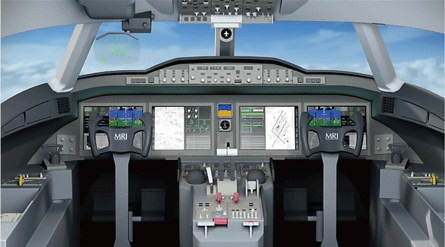 |
|---|
© Mitsubishi AircraftMHI says that pilots prefer conventional yoke control wheel, rather than side sticks |
"From our studies, we learnt that pilots also prefer a conventional yoke control wheel. Our entire cockpit layout is based on market research," says Miyakawa.
The four-abreast cabin will be innovative, with gentle ceiling lights curving to form the shape of Japan's national symbol, Mount Fuji. There are also large overhead compartments and seats that use a patented "3D-Net Textile", says Mitsubishi. This textile provides passengers with a higher level of comfort, better shock and vibration absorption, weight savings, and allows the seat to be slimmer so that leg-room is maintained at reduced seat pitches, it adds.
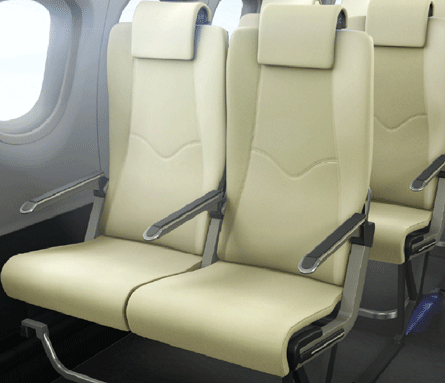 |
|---|
© Mitsubishi AircraftSeats will use a patented textile designed to provide a higher level of comfort |
DIFFERENTIATION
Selling that to airlines is the responsibility of Yosuke Takigawa, senior vice-president for sales and marketing, and his team. They have been on the road promoting the aircraft since the first MRJ cabin mock-up was displayed at the 2007 Paris air show.
The challenge, he says, is to differentiate the MRJ from the rest of the field. Not only is the aircraft up against Bombardier and Embraer, which have the long-established CRJ and E-Jet families respectively, it will also compete with China's ACAC ARJ-21 and Russia's Sukhoi Superjet that will reach the market first.
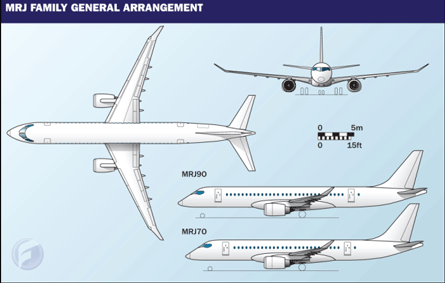
"Our message is simple. We are the next generation regional jet. We offer fuel savings through a new-generation engine, a superior on-board experience compared with other aircraft, and a platform that delivers everything we promise," he adds. "Some say that it is a crowded field, others say that it is saturated. Our projections show that there will be a demand for 5,000 regional jets in the next 20 years. With the performance and improvements that we offer, we hope to capture 20% of that."
The first target, though, is 300 aircraft. That is the programme's financial break-even point, and Takigawa says Mitsubishi has done its homework. "Once you enter the production stage you will manufacture the aircraft for 20 years. Yes, there is always a risk involved, but we are preparing to challenge the market."
For now, Mitsubishi has only 15 firm orders and 10 options, all for the MRJ-90 from ANA. The airline will replace some of its 25 Boeing 737-500s with them, but it does not know when it will firm up the options and is unlikely to order any more than that anyway.
"According to our forecast for the future Japanese domestic market, 15 firm and 10 options should be sufficient. Since the first aircraft delivery is scheduled for the end-2013, we do not have any idea as to when we will firm up the options," says Ichiro Hidaka, the corporate planning manager at ANA.

"One of our subsidiary airlines will most probably operate the MRJ, but the decision is not yet made. The base airport of this aircraft will be one of the major local cities like Nagoya, Fukuoka, or Osaka, and it will fly between these major local cities and smaller cities."
Japan Airlines could come on board later, but a decision is not imminent. The carrier has ordered 10 Embraer 170s to take advantage of the expansion of Tokyo's Haneda Airport in 2010. Any study into a new batch of regional jets will come only around then, it says. Toda, though, remains confident. "We believe that if they really understand our aircraft's ability, they will make a decision," he says.
China could be the hardest market to crack, given that its domestic carriers may be under pressure to order the Chinese-developed ARJ-21. The opening up of the China-Taiwan cross-straits flights may bring interest in the MRJ from Taiwanese carriers and some smaller independent Chinese airlines. Beyond China, Mitsubishi expects to be competitive.
"We are talking to all airlines and there is no real geographic limit. There are some interesting areas like the Middle East. They may produce crude oil, but high jet fuel prices affect them as well. The region is booming and there is a great opportunity for growth there," says Takigawa.
CRUCIAL LEASING
Leasing companies will be crucial, he adds. "Traditionally, 25-30% of aircraft have been bought by leasing companies. But they are new to the regional aircraft segment and it may take some time to persuade them. Obviously, people share the idea that once you get a big customer on board, it is a good programme."
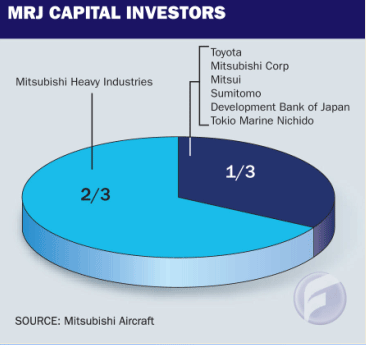
The problem, though, is that GE has been the incumbent engine supplier in the regional sector until now and its sister financing arm, GE Commercial Aviation Services, has supported all the programmes as well. That would probably not work with P&W in the picture with the MRJ. However, that could also signal the entry of International Lease Finance into the regional jet business. ILFC, which operates a portfolio of around 900 aircraft, has traditionally drawn a line below the Airbus A320 family and Boeing 737 size category. However, it is evaluating the 100-seat jet market and talking to Mitsubishi.
The company, though, is worried about projecting the residual values of regional jets in the long term as the smaller jets depreciate faster than the bigger aircraft. Capital costs present a further sticking point. "We are struggling with the capital cost per seat for these new aircraft versus an A320/737-800 category aircraft, as well as the fact that their unit [per ASM] operating costs are still higher than the Airbus/Boeing latest models," says ILFC chief executive Steven Udvar-Hazy.
Japanese companies could also come on board and help with the financing and leasing of the MRJ. Three trading houses, Mitsubishi Corp, Sumitomo Corp and Mitsui & Co, are also shareholders in Mitsubishi Aircraft. Along with the Nippon Export and Investment Insurance, they could help to promote the aircraft globally. "Their global experience in sales and financing will be useful," says Takigawa.
Signing up Boeing as a marketing and after-sales consultant could be a crucial step, as would be getting Saab to provide customer support globally. It is still unclear how deeply Boeing would be involved, says Aboulafia. "Anyone can build an aircraft. The real talent is sales, support, marketing and finance. Boeing brings those skills to the table," he says.
"It's tough to tell whether Boeing's help on the MRJ represents a strong commitment to a new product or merely a passive effort to maintain a long-standing strong business partnership. After all, Boeing has consistently said that it has no interest in the regional market."
FUNDING HICCUP
A potential hiccup relates to the funding for the MRJ, with the Japanese government saying that it will provide up to ¥50 billion ($476 million) of the projected ¥150 billion development cost as repayable launch aid. Bombardier is closely monitoring the situation to see if that funding contravenes World Trade Organisation rules, and Pritchard and MacPherson point out that the MRJ benefits from direct and indirect subsidies to the Japanese industry.
Toda, however, dismisses any claims of illegal subsidies: "We don't know what the final amount of loans will be. We have an annual system of funding and the government lends money, but we are certain that it is legal under WTO regulations."
TAKING SHOTS
Competitors have already begun to take shots at the aircraft, with some pointing out that its projected weight could lower the benefits of the GTF engine. Mitsubishi retorts that weight reduction was a goal even before others began to point it out. "Here's the thing," says Takigawa with a smile. "If our competitors are talking about us and taking pot-shots, it means that we have a product they are worried about."
Ignoring the MRJ, however, could be foolhardy. It has lined up top-notch suppliers, signed up experienced consultants, and will benefit from the experience that its shareholders bring to the table. Toyota Motors, which owns 10% of Mitsubishi Aircraft, is now the leader in an automobile industry that US companies once dominated. Its experience could help Mitsubishi make its mark in the regional jet market, say observers.
Pritchard and MacPherson predict that the Western domination of the commercial aircraft market will end by the mid-2010s. "It would be unwise to dismiss Japan as a potential playersimply because it took other players a long time to establish a credible foothold in this industry," they say. "A shift to the east appears to be forming on the long-range radar sweep."
Mitsubishi could be leading that charge with the MRJ.
Source: Flight International



















